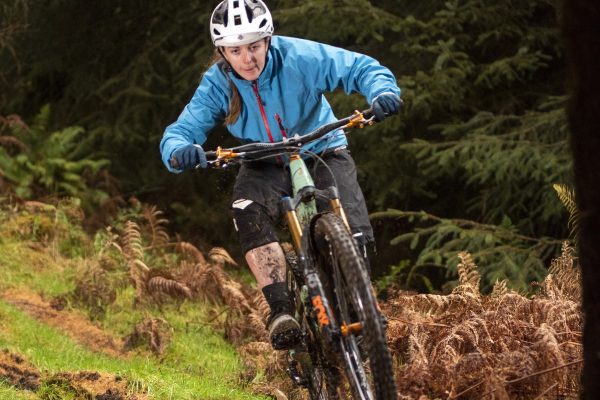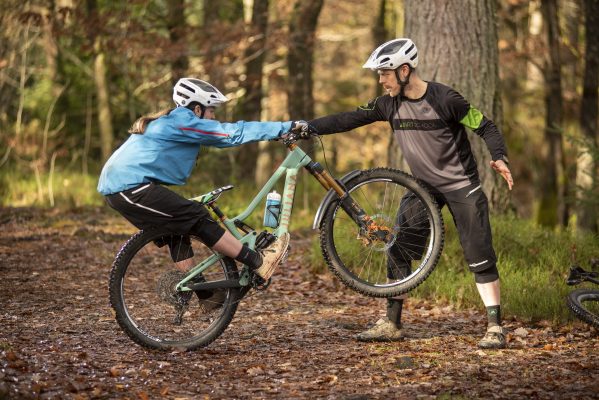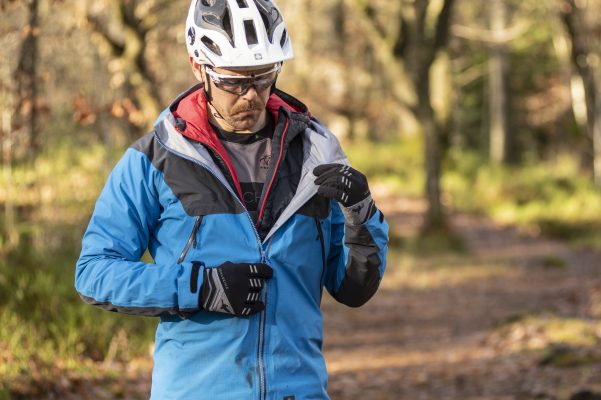Winter skills clinic
Be armed and prepared in winter and you’ll learn to embrace its slithery conditions and sub-optimal traction instead of fleeing to a warm sofa and Netflix.
>>> Our ultimate foul weather recommended riding kit
This summer was one to remember, but now were hub-deep in the reality of winter in the UK. So we’re going to look at specific ways of dealing with winter, and specifically the lack of traction and sideways antics this season brings. We’ll look at the things the will most likely catch you out on the most terrifying wet weather features. And we’ll arm you with some practical sessions so you can survive the season safely and actually start to feel confident when conditions are far from predictable.

We’re joined by Dirt School’s newest coach, Janey Kennedy. Being an experienced rider herself, Janey will be able to give us some excellent demonstrations of good technique. Being a smaller rider Janey has to really make the most of her range of motion on the bike.
Janey was an experienced guide for Go-Where riding holidays, and now teaches mountain biking for Dirt School in the Tweed Valley… in her spare time she’s a total pinner and enduro racer.

The manual
Most of the techniques that we’ll cover this month are tethered to the manual in some way. Whether it’s starting low, using your full range of motion, or even just pushing with your legs, the manual is at the centre of modern riding. You don’t have to be able to keep your manual going for hundreds of meters down a fire road but you do have to be able to keep it up for a bike length by driving it with your legs.
If you look at Janey demonstrating the correct way of keeping her front wheel light, she’s not pulling up on the bars at all. Instead she’s hanging back on completely locked out arms so that her weight is above and slightly behind her rear axle. Notice how she also has her legs bent here. This means that if the front wheel goes heavy and starts to return to the ground she can drive it back up by pushing with her legs.

Notice how in the above image she has straightened her legs so much that her hips are now well and truly behind the rear axle. She’s lightened the front wheel so effectively that Andy doesn’t even have to hold on. By moving her hips horizontally forwards and backwards with the range of motion through her legs, she’ll be able to adjust her tipping point and keep the front wheel off the ground. At no point would she pull on the bars.

He’s not pulling the bars, he’s driving his back wheel into the puddle with a deliberate push of the legs.
Puddles
Seeing as it’s now winter and there are puddles everywhere, why not use them as target practice for your manuals. Remember and come in close to your bike with your body low and your legs and arms bent. This will allow you to then push the bike forwards so that your arms are locked and your legs can drive your front end up by pushing from underneath. Remember you’re not trying to lift your front wheel over the puddle. You’re trying to splash your back wheel into the puddle with a deliberate push of the legs.

Notice how Andy still has his hips lined up with where he wants to go. His outside foot may be down but he’s still allowing for movement by keeping his legs bent. Sometimes you just got to trust the grip and hang on.
Slippery trails
As well as throwing up all kinds of debris, winter also makes everything on the trail a lot more slippery. We get asked all the time, “How do I stop slipping on roots?” The honest answer is you don’t! Roots are slippery when they’re wet. What you have to do instead is be comfortable with the extra movement that you’re going to encounter. The best way to do this is to be very conscious of your body position and stay low.

A low body position will allow you so much more control this winter. Notice how close to her bars Janey is on this corner. As her front wheel slides she’ll have plenty room to let it happen and won’t even notice that her tyre is moving on the trail.
Body position
When a rider looses confidence they tend to start moving away from their bike and going for the brakes. At this time of year you’re only going to get away with riding like this if you’re either going very slow, or if the trail that you’re on don’t really pose any sort of threat. As soon as you’re on anything technical or textured you’re going to suffer. Instead, be aware that this will likely happen to you and be ready with a different approach. Get closer to the bike and pay careful attention to where you brake. The extra range of motion will allow you to stay neutral as your bike tyres slide about underneath you, and mean that you can stay in balance even when the trail is throwing sniper roots at you left right and centre. As soon as the bike becomes lively underneath you reset back to a low position with your elbows out. You’ll be amazed by how much movement you can handle without it throwing you off line.

Here Andy links two grippy parts of the trail together and avoids all the roots. He’s not lifting his bike over, but rather pushing when he can trust the traction.
Grip points
Whether going up or down, the best thing you can do in winter is deliberately look for your grip points. Once you learn the kinds of things that will help you out on a muddy or slippy day, then you start to look for them everywhere. A good grip point might be something with a little camber in your favour, it might be a patch of ground with no roots or sloppy mud on it, it might even just be the only piece of dirt on an icy slab of rock. Whatever it is it’s better than what you’re scared of sliding on, so aim for a grip point and go heavy by driving your weight into it once you’re there. When you get into the habit of linking them all together you’ll forget that the big scary features pose any kind of threat as you’ll be focusing all your attention on the more positive aspects of the trail.
Cornering
When it comes to corners you’re going to have to allow for more movement than normal. Do this by keeping your head in the middle of your bars and above the stem, and think about keeping your back flatter than normal so that you’re spread out low over your whole bike. As the corner progresses try and keep your upper body consistent with the bars, forks, and front wheel of your bike, and allow your hips and knees to be free of the saddle and frame. This means that if your tyres start to slide you’ll have plenty of movement available to stay in control.
Slippy technical climbs
Climbing on textured or wet surfaces is a delicate art. Too much power and you spin out. Not enough and you come to a stop! The trick is to spot the places where you can trust the grip and go a little harder where you can trust the traction. You’re going to have to let your tyres and bike go light over the worst of the features so you may have to stay a little out of the saddle to allow for that extra movement. As soon as you’re back on smooth ground – and that might only be for a split second, give it beans. You can still turn your pedals and create forward momentum of the slippy stuff, just go easy and if it breaks traction you’ll likely spin out quickly and loose a lot of your momentum.

Clothing
Dressing for the occasion and knowing what to wear when the weather is changeable is a skill in itself. In really cold environments you want to stay as dry as you can manage, so be prepared to shed layers or add them as the ride progresses or the weather changes. Here are some winter essentials.
Eye protection
A good pair of clear lenses are a must for winter in the UK. There will likely be days where you just can’t keep them clear enough to see out of them, but every chance you get to wear them you should. Picking mud and pine needles out of your eye two days after a ride in no fun and can lead to serious problems.
Waterproofs
A good waterproof jacket is a no brainer, but a good pair of waterproof shorts can make just as big a difference. If you’re out in terrible weather then it’s only a matter of time before you get soaked through, but a waterproof outfit will also keep the wind out, so worn with the appropriate layers will remain warm on the craziest of adventures.
Layers
A long sleeved base layer, a good mid layer, and a waterproof outer shell is a great winter combination. You may even want to add a polertec or down layer if it’s really cold or if you’re doing a lot of standing about. Having too much is always better than not having enough.



